An Introduction to
Washington, D.C. License Plate Validation Stickers
To reach our photo gallery of D.C. plate validation stickers at the bottom of this page, click here.
To reach a separate page upon which information about validation stickers is provided, click here.
Use these links to reach the section of baseplate-specific pages in which is provided specific information about the correlation of general-issue registration numbers to sticker serial numbers (described on this page) on the 1968, 1974, and 1978 baseplates:
1968 Base - 1974 Base - 1978 Base
If you know something about license plates and registration systems you probably think it's a little strange to devote an entire page of a jurisdiction-specific Web site to stickers. Well, when it comes to most places you'd be correct. Washington, D.C., however, has treated its stickers a little differently as compared to most other U.S. and Canada jurisdictions, at least during the first 20 years that they were used, and this special treatment deserves a dedicated discussion. If you want to read about one of the plate-related quirks that makes the Nation's Capital a little different, you've come to the right place!
What's So Strange About D.C. Stickers?
Well, it's a long story. Or, at least it is if you include background information that's needed by folks that aren't familiar with how registrations, plates, and stickers are issued. So as not to keep seasoned students of license plates in the dark, however, here it is: From the introduction of D.C. stickers in 1967 (dated "68") through mid-1987 (dated "88"), the last three digits of the serial number on those stickers matched the last three numbers on the plate to which they were applied prior to being issued. So you see, it's not the stickers per se, but rather how particular ones were chosen to be affixed to certain plates.
Doesn't sound too strange? Maybe not, but it is. The only other North American jurisdiction known to DCplates.net to have used such a weird system is Missouri, which effectively abandoned the system (because it switched from multi-year stickered plates back to annual plates) just as D.C. was getting started!
 Why did D.C. go to the trouble to issue stickers that matched the plate to which they were attached? We don't know, but we'd like to hear from anyone with an explanation! The logical one initially seems to be that it allows law enforcement officers and others to determine if a sticker on a particular plate was illegally removed from another plate to validate an unrenewed registration. Sounds reasonable, but it really isn't, for a few reasons. First of all, only the first sticker applied to only some D.C. plates had the matching serial number, and as difficult as it is to remove plate stickers that have been applied on top of older stickers, it's nearly impossible to remove a sticker that's the only one on a plate and has therefore been applied directly to the plate. Also, the sticker serial number is not easy to see: it's printed in tiny numbers. It's value in aiding in sticker theft detection seems negligible.
Why did D.C. go to the trouble to issue stickers that matched the plate to which they were attached? We don't know, but we'd like to hear from anyone with an explanation! The logical one initially seems to be that it allows law enforcement officers and others to determine if a sticker on a particular plate was illegally removed from another plate to validate an unrenewed registration. Sounds reasonable, but it really isn't, for a few reasons. First of all, only the first sticker applied to only some D.C. plates had the matching serial number, and as difficult as it is to remove plate stickers that have been applied on top of older stickers, it's nearly impossible to remove a sticker that's the only one on a plate and has therefore been applied directly to the plate. Also, the sticker serial number is not easy to see: it's printed in tiny numbers. It's value in aiding in sticker theft detection seems negligible.
Before we continue, it's also worth noting that readers should not confuse what D.C. did with its stickers from 1967 through 1987 with what Idaho did and Massachusetts still does with theirs, which is to have the final digit of the plate correspond to the month of expiration (and that is therefore shown on the sticker). It's typically relatively easy to see a plate's expiration month becuase this data is usually displayed in lettering at least large enough to see from a short distance (as opposed to the relative illegibility of sticker serial numbers). Therefore, it's actually not a bad enforcement tool to have, for example, all plates that end in the number 1 expire in January. What D.C. did is slightly different and probably less useful; which, of course, is probably why the practice was abandoned in mid-1987.
This is as good a time as any to indicate that the 1967-87 D.C. matching sticker rule applies only to annual year stickers (e.g. those marked 76, 77, 78, etc.), not to month stickers (JAN, FEB, MAR, etc.). Also, and most importantly, it applies only to natural plates and stickers: those issued for new registrations, not renewals or replacements of older plates, as discussed in detail below.
Why Is This Relevant?
Good question! This is primarily relevant to license plate collectors that are assembling a one-per-year collection of D.C. plates. In our opinion, the truly correct collection is comprised of natural plates. When it comes to Washington, D.C., the sticker serial number on natural plates issued during the aforementioned twenty-year period must match the plate number.
Washington, D.C. one-per-year sets comprised of natural plates appear more correct and orderly because the numbers increase sequentially from year to year. For example, listed below is information about plates of a six-year span in DCplates.net's collection. Even though a new baseplate was introduced (for new registrations only) in 1978, numbers being issued kept progressing upward. If some non-natural plates were allowed in the set, lower-number plates might follow higher-number plates, which wouldn't make sense from a chronological issuance standpoint.
Baseplate |
Exp. Year |
Plate No. |
Sticker No. |
1974 |
77 |
402-529 |
407529 |
" |
78 |
450-163 |
700163 |
1978 |
79 |
538-596 |
683996 |
" |
80 |
565-603 |
103603 |
" |
81 |
673-591 |
909591 |
" |
82 |
692-958 |
107958 |
Note the closeness of the plate and sticker serial numbers for the first plate listed: 402-529 and 407529. For this particular year, sticker serial numbers on natural general-issue passenger car plates are 5,000 digits higher than the plate number. Information about this relationship for many years is presented on a separate page. Note also that the fourth digit on the plate expiring in 1979 does not match. This seems to have happened once in a while, so there are occasional exceptions to the rule of the final three numbers matching. No examples have been observed, however, in which at least the final two numbers don't match.
What Is a Natural License Plate?
The term "natural" used in the context of modern multi-year license plates validated with stickers is one coined by plate collectors to describe, in its simplest terms, a multi-year plate with only a single sticker. As discussed below, however, not all plates with a single sticker are naturals. A distinction must be made between a plate with only one sticker because it was issued in evidence of a new registration (a natural plate) and a plate replaced with all plates within a jurisdiction (in what collectors refer to as a general reissuance) that was initially used for a period without a sticker and that is then renewed with its first sticker (not a natural plate). An example using the 1974 ("Bicentennial") base is shown below to illustrate this critical distinction.
In any jurisdiction besides D.C., a natural plate would have only a single year sticker. There is one rare set of circumstances in the District that occasionally resulted in natural plates having two year stickers, a subject introduced in the final paragraph of this section, but these instances are extremely rare. Therfore, for purposes of our introduction to natural plates we'll stick with the premise that all natural plates have only a single year sticker, but not all plates with a single sticker are naturals.
A natural plate is created only when a motorist purchases a new registration (for either a new or used vehicle). Naturals cannot result:
-
When a registration is renewed, even if the sticker issued in evidence of the renewal is the first to be applied to the plate,
-
When a registration is transferred between vehicles, registrants, or both, and
-
When or any time after a plate is replaced in conjunction with a routine plate-replacement program.
Defining a natural plate and describing what it represents to someone unfamiliar with the term would really be a lot easier if there weren't one exception that, to folks that do understand the term, flies in the face of logic. We know of no other instance in the U.S. or Canada in which a plate with two year stickers can be considered a natural, but unfortunately this can happen in Washington, D.C. For an example and explanation as to how this can happen, visit the 1968 baseplate page.
How to Spot a Natural D.C. Plate
For plates validated with stickers from 1968 through early 1988, the easiest way is, of course, to see if the final three digits of the sticker serial number match the final three digits of the plate number. This agreement in numbers should be present in all instances in which a D.C. plate has only one sticker, with these three exceptions:
-
Most 1966 plates (dated 3-31-67) with a "68" sticker are not naturals,
-
Most 1968 (undated black-on-white) baseplates with a "70" sticker are not naturals, and
-
Most 1974 (Bicentennial) baseplates with a "76" sticker are not naturals.
All of these exceptions are classified as such due to the same set of circumstances. Each of these baseplates was used for a general reissuance (as well as for later new registrations), which means that every owner of a registered vehicle received a set of them to replace his or her older plates. For example, everyone with a valid set of 1966 plates on their car received a set of 1968 plates when the two-year life of the '66 plate ended on March 31, 1968, and all valid 1968 plates were replaced at the end of their six-year stint on March 31, 1974.
Each of these baseplates issued to replace older plates were used for their first year without a sticker. The first sticker to be applied to them was not the result of a new (i.e. natural) registration, but rather a renewal. Matching sticker serial and plate numbers are present only on plates to which the stickers were applied before issuance at the facility where they were manufactured, whereas no attempt was made to distribute stickers with any digits that matched the plate number when renewal transactions were processed. Therefore, the reason that the serial number of the first sticker applied to each of the plates listed above usually doesn't match the plate number is because they were applied to indicate the renewal of an existing registration, not the issuance of a new one. The volume of renewals from registration year to registration year far outweighs the number of new registrations issued during any one registration year, which is why there are, for example, far more Bicentennial plates with non-matching "76" stickers than there are with matching ones.
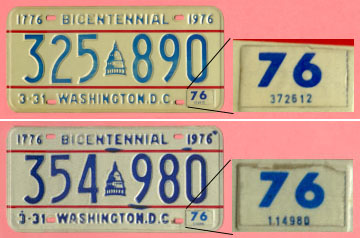 These two 1974 baseplates provide a good example. When a few hundred thousand sets of them were distributed to D.C. motorists in early 1974 to replace the plain black-on-white 1968 plates, the lowest numbers were used first. We can tell that plate 325-890 was issued as a replacement for an older plate because the "76" sticker issued in early 1975 has a serial number of 372612: the final three numbers don't match the final numbers on the plate. However, we can also tell that number 354-980 was issued in conjunction with a new registration issued during the 1975-76 registration year (April 1, 1975, through March 31, 1976) because the sticker serial number is 114980, which does match the plate. Note also the different shades of white reflective sheeting used to make these plates. The sheeting covering plate 325-890 has a distinct off-white or ivory shade (possibly due more to the color of the clear lacquer covering the plate rather than the sheeting itself) whereas plate 354-980 is a much brighter shade of white.
These two 1974 baseplates provide a good example. When a few hundred thousand sets of them were distributed to D.C. motorists in early 1974 to replace the plain black-on-white 1968 plates, the lowest numbers were used first. We can tell that plate 325-890 was issued as a replacement for an older plate because the "76" sticker issued in early 1975 has a serial number of 372612: the final three numbers don't match the final numbers on the plate. However, we can also tell that number 354-980 was issued in conjunction with a new registration issued during the 1975-76 registration year (April 1, 1975, through March 31, 1976) because the sticker serial number is 114980, which does match the plate. Note also the different shades of white reflective sheeting used to make these plates. The sheeting covering plate 325-890 has a distinct off-white or ivory shade (possibly due more to the color of the clear lacquer covering the plate rather than the sheeting itself) whereas plate 354-980 is a much brighter shade of white.
How to Spot a Fake Natural D.C. Plate
Washington, D.C. plates are tough for collectors to find, especially in nice condition, due to the low number issued and urban environment in which they are used. On occasion, collectors locate nice plates with defaced or missing stickers, and the natural (no pun intended!) inclination is to substitute a nice used one removed from another plate. With plates of most jurisdictions, a patient collector who's skilled at removing and replacing stickers can successfully achieve this switch. However, it's almost impossible to do it with D.C. plates and to get it right because of the matching number rule.
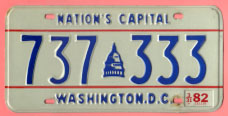 Pictured here is a beautiful 1978 base (with an interesting number, too), that has what appears to be a natural 3-31-82 sticker. It's the only sticker on the plate (i.e. there aren't any others under it), and '82 is the correct year based upon the plate number, but we know this is a fake natural because the sticker serial number is 232239: the final three numbers don't match the plate. In fact, DCplates.net knows for a fact this is a fake because it executed the forgery! We couldn't resist when faced with such a nice plate from which a well-meaning motorist tried (somewhat successfully) to remove the sticker, probably before turing it over to a collector or discarding it. The remains of the original 3-31-82 sticker were intact enough to see the original serial number: 410033 (another example of only the final two numbers matching, as discussed above). Sticker no. 232239 was a renewal sticker taken from plate no. 636-428, and all of this has been written on the back of the plate in order to not confuse future collectors who might be observant enough to notice the discrepancy between plate and sticker serial numbers.
Pictured here is a beautiful 1978 base (with an interesting number, too), that has what appears to be a natural 3-31-82 sticker. It's the only sticker on the plate (i.e. there aren't any others under it), and '82 is the correct year based upon the plate number, but we know this is a fake natural because the sticker serial number is 232239: the final three numbers don't match the plate. In fact, DCplates.net knows for a fact this is a fake because it executed the forgery! We couldn't resist when faced with such a nice plate from which a well-meaning motorist tried (somewhat successfully) to remove the sticker, probably before turing it over to a collector or discarding it. The remains of the original 3-31-82 sticker were intact enough to see the original serial number: 410033 (another example of only the final two numbers matching, as discussed above). Sticker no. 232239 was a renewal sticker taken from plate no. 636-428, and all of this has been written on the back of the plate in order to not confuse future collectors who might be observant enough to notice the discrepancy between plate and sticker serial numbers.
All Weird Things Must Come to an End
We don't know exactly when the matching number rule came to an end. We have, however, observed natural 1984 ("Capital City") baseplates validated with 1988 stickers that have the matching serial and plate numbers, and others that don't. Because plates with natural '88 stickers were issued in 1987, that's the year associated with the abandonment of this unusual stickering practice. Specifically, we've seen plate no. 241-050 that expired in May 1988 that has a matching sticker, and no. 275-319 with an October 1988 expiration that does not. Perhaps a contributing factor to discarding the matching sticker rule is that the '88 stickers are the first issued with a blue background, and the shade of blue is dark enough that the black serial number is almost impossible to read!
D.C. Passenger Plate Sticker Gallery
Pictured below are examples of Washington, D.C. license plate stickers issued since 1967 (marked "68"). All stickers are shown in the same scale. Dated 69 and 75 stickers are far more scarce than those of other years through 2003 because they were issued only for use on personalized plates. (New plates were issued for all other types for these two registration years.) Two styles of 1984 stickers were issued due to the District's adoption of a staggered registration system during 1983, and for 2003 there are two distinctive sticker styles. Most private passenger registrations expiring in 2004 and all expiring in 2005 and later years were validated by a windshield sticker, so dated "04" and later stickers are scarce.
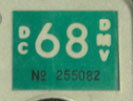 |
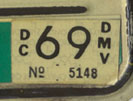 |
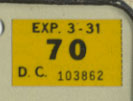 |
 |
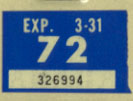 |
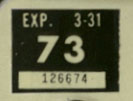 |
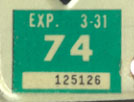 |
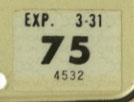 |
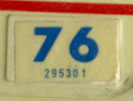 |
 |
 |
 |
 |
 |
 |
 |
 |
 |
 |
 |
 |
 |
 |
 |
 |
 |
 |
 |
 |
 |
 |
 |
 |
 |
 |
 |
 |
 |
 Dated "04" validation stickers appeared on relatively few passenger car plates: only general-issue plates that were renewed for the optional two-year period during 2002, as well as plates issued in conjunction with a new registration between Jan. 1 and mid-April 2002 in instances in which the vehicle owner chose the two-year option. In addition, these stickers were used to validate dealer, motorcycle, trailer, and apportioned truck plates during 2003.
Dated "04" validation stickers appeared on relatively few passenger car plates: only general-issue plates that were renewed for the optional two-year period during 2002, as well as plates issued in conjunction with a new registration between Jan. 1 and mid-April 2002 in instances in which the vehicle owner chose the two-year option. In addition, these stickers were used to validate dealer, motorcycle, trailer, and apportioned truck plates during 2003.
Stickers issued during 2004 (dated "05") and later years have been used primarily on apportioned truck, motorcycle, and trailer plates, although some 2010-11 dealer plates were also validated with stickers. Passenger car plates affixed to most vehicles owned by the federal government (such as those used by the U.S. Secret Service) also continue to be validated with plate stickers.
 |
 |
 |
 |
 |
 |
 |
 |
Characteristics of stickers of recent years are as follows:
Exp. Year |
Colors |
Link to Image |
2013 |
red on white |
|
2014 |
||
2015 |
green on white |
|
2016 |
blue on white |
|
2017 |
red on white |
|
2018 |
|
This page last updated on December 31, 2017 |
 |
|
copyright 2006-2018 Eastern Seaboard Press Information and images on this Web site may not be copied or reproduced in any manner without consent of the owner. For information, send an e-mail to admin@DCplates.net |














